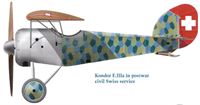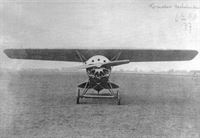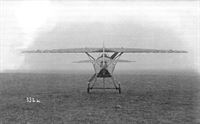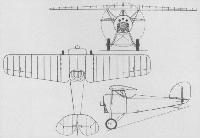
Описание
Страна: Германия
Год: 1918
Fighter
В.Обухович, А.Никифоров Самолеты Первой Мировой войны
После победы на втором конкурсе истребителей моноплана-"парасоль" Фоккер D VIII к созданию подобных аппаратов приступили и некоторые другие компании. Так, конструктор компании "Кондор" Вальтер Ретхель (будущий ведущий конструктор Me 109) в середине 1918 г. разработал истребитель Е.З. От машины Фоккера новый самолет отличался конструкцией крыла. Оно было цельнодеревянным толстого профиля с фанерной обшивкой. Листы обшивки снаружи (по нервюрам) усиливались Л-образными накладками. Фюзеляж конструктивно напоминал Фоккера D VIII: сварная ферма из стальных труб скруглялась фанерными панелями и частично оклеивалась полотном. Киль был деревянным, силовой набор стабилизатора из стальных труб. Оснащался самолет мощным ротативным двигателем Оберурсель Ur.III (160 л. с.) в стандартном, для подобных двигателей мотокапоте. На варианте Е.3а устанавливался двигатель Гебель Goe.III в 200 л. с, укрытый оригинальным капотом.
Самолет G.3 участвовал в конкурсе истребителей, где продемонстрировал отличные характеристики, а также удивил прочностью конструкции. Летчики-истребители высоко оценили эту машину.
Командование заказало 100 истребителей, получивших обозначение DI. Вооружались они двумя синхропулеметами "Шпандау*. Однако до конца войны удалось поставить в войска не более 10 машин, которые в боях не участвовали.
Технические данные Кондор D I
Двигатель 1 х Оберурсель Ur.III (160 л. с.)
Размеры:
размах х длина 9,0 х 5,5 м
Площадь крыльев 12,75 м2
Вес
пустого 460 кг
взлетный 640 кг
Максимальная скорость 190 км/ч
Вооружение:
стрелковое 2 х 7,62-мм синхронных пулемета "Шпандау"
Описание:
- В.Обухович, А.Никифоров Самолеты Первой Мировой войны
- O.Thetford, P.Gray German Aircraft of the First World War (Putnam)
- W.Green, G.Swanborough The Complete Book of Fighters
- J.Herris German Aircraft of Minor Manufacturers in WW1. Vol I (A Centennial Perspective on Great War Airplanes 49)
Фотографии
-
Форум - Breguet's Aircraft Challenge /WWW/
Кондор D I
-
J.Herris - German Aircraft of Minor Manufacturers in WW1. Volume I /Centennial Perspective/ (49)
Kondor E.IIIa prototype
-
J.Herris - German Aircraft of Minor Manufacturers in WW1. Volume I /Centennial Perspective/ (49)
Kondor E.IIIa in postwar civil Swiss service
-
J.Herris - German Aircraft of Minor Manufacturers in WW1. Volume I /Centennial Perspective/ (49)
Детище конструктора Вальтера Ретхеля - истребитель Кондор DI
The Kondor E III Wireless Parasol Monoplane. (140 h.p. Oberursel rotary engine), which is said to give a speed of 195 kms. per hour and a climb of 5,000 metres in 16 minutes.
The Kondor E.III was powered by the 160 hp Oberursel Ur.III rotary. The E.III had a cutaway cowl and no spinner was fitted. No armament is fitted. This E.III competed in the Third Fighter Competition. High-power German rotaries were now becoming available. -
J.Herris - German Aircraft of Minor Manufacturers in WW1. Volume I /Centennial Perspective/ (49)
Kondor E.III powered by an 160 hp Oberursel UR.III. The Kondor E.III and E.IIIa were entered in Germany's Third Fighter Competion in October 1918. During evaluation the E.III demonstrated much better flight characteristics than the production Fokker D.VIII parasol monoplane and its wing was much stronger.
-
J.Herris - German Aircraft of Minor Manufacturers in WW1. Volume I /Centennial Perspective/ (49)
Powered by a 160 hp Goebel Goe.III rotary, the Kondor E.IIIa competed at the Third Fighter Competition. The E.IIIa was faster and had a much better rate of climb than the E.III due to its superior engine. (Peter M. Grosz collection, STDB)
The Kondor E IIIa "Wireless" Parasol Monoplane (200 h.p. Goebel rotary engine) which gives a speed of 200 kms. per hour and a climb of 5,000 metres in 11 minutes. -
J.Herris - German Aircraft of Minor Manufacturers in WW1. Volume I /Centennial Perspective/ (49)
Another contender and Fokker D VIII look-alike that took part in the third 1918 Adlershof fighter trial, held in October, was the Kondor E 3a seen here. The E 3A employed a 180hp Goebel rotary. A second specimen, the 160hp Oberursal U III powered Kondor E 3, also participated in this competition. The external wing ribbing, along with the aft wing centre section cut-out help to highlight that this design employed the still novel thick sectioned, high lift wing. Top level speeds for the E 3 and E 3a were reported to be 120mph and 124mph, respectively.
-
J.Herris - German Aircraft of Minor Manufacturers in WW1. Volume I /Centennial Perspective/ (49)
Rearview of the Kondor E.IIIa. The E.IIIa was faster and had a much better rate of climb than the E.III due to its superior engine. It offered better flying qualities than the Fokker D.VIII monoplane and had a stronger wing.
-
J.Herris - German Aircraft of Minor Manufacturers in WW1. Volume I /Centennial Perspective/ (49)
The Kondor E.IIIa was powered by the 160 hp Goebel Goe.III rotary; the E.IIIa had a spinner and full cowl.
-
J.Herris - German Aircraft of Minor Manufacturers in WW1. Volume I /Centennial Perspective/ (49)
Powered by a 160 hp Goebel Goe.III rotary, the Kondor D.IIIa competed at the Third Fighter Competition. This is a 1919 view of an unarmed Kondor D.IIIa in civil Swiss service with the owner, Alfred Comte, in the cockpit.
-
M.Dusing - German Aviation Industry in WWI. Volume 1 /Centennial Perspective/ (84)
Kondor E.IIIa (1918). Competing at the 3rd Fighter Competition in October, the Kondor E.III demonstrated higher wing strength and roll rate than the Fokker D.VIII. Unlike the Fokker, the Kondor's wing did not vibrate at high speed. The E.IIIa was faster and had a much better climb rate than the E.III due to its engine.
-
J.Herris - German Aircraft of Minor Manufacturers in WW1. Volume I /Centennial Perspective/ (49)
The Kondor E.IIIa was powered by the 160 hp Goebel Goe.III rotary and had a spinner and full cowl. The Kondor E.III was powered by the 160hp Oberursel Ur.III rotary and had a cutaway cowl and no spinner. This aircraft was photographed in 1919 in Switzerland, where it was employed for aerobatic displays. An LVG C.V is in the background.
Другие самолёты на фотографии: LVG C.V - Германия - 1917
-
J.Herris - German Aircraft of Minor Manufacturers in WW1. Volume I /Centennial Perspective/ (49)
This Kondor E.IIIa was photographed in 1919 in Switzerland, it was owned by the Comte, Mittleholzer & Co. (Aero Gesellschaft). An LVG C.V in Swiss markings is at right.
Другие самолёты на фотографии: LVG C.V - Германия - 1917
-
J.Herris - German Aircraft of Minor Manufacturers in WW1. Volume I /Centennial Perspective/ (49)
A Kondor E.IIIa at Cuyk, Holland, in 1920; the pilot is Hans Wende of NAVO.The unusual wing structure is evident. Unlike the Fokker D.VIII, the cantilever wing did not vibrate at high speed. The stronger wing structure of the E.III/IIIa also gave it a better roll rate than the Fokker D.VIII, which is very important for a fighter.
-
M.Dusing - German Aviation Industry in WWI. Volume 1 /Centennial Perspective/ (84)
Kondor E.III: Tubular steel construction of the fuselage structure.
-
M.Dusing - German Aviation Industry in WWI. Volume 1 /Centennial Perspective/ (84)
Wooden landing gear on the Kondor E.III.
-
M.Dusing - German Aviation Industry in WWI. Volume 1 /Centennial Perspective/ (84)
Kondor E.III: 4-spar wing structure.
-
W.Green, G.Swanborough - The Complete Book of Fighters
Ur III-powered E 3.





















